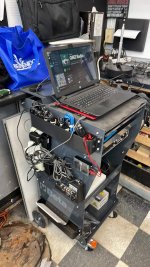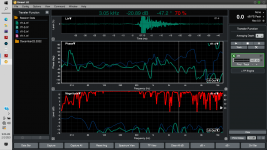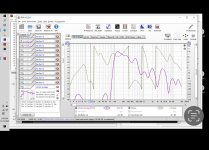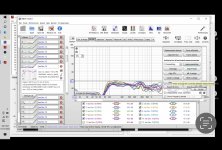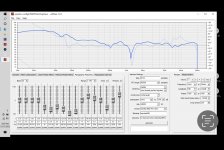Hi gang ,
So , I was hoping to gather any smaart users that are also proficient in REW and rephase.
So , I have been using REW with rephase and making firs….. took me way longer then it should have to learn it because I’m a clunker. 😛 but I’m a master now!
So , here’s what is going on and maybe someone can help
With REW, I have CSL umik2 and a creative sound card (separate clocks separate devices yah de yah etc etc….
I take 9 gated FDW 15cy measurements around my head. I use REW and shift IR, smooth , time align and vector average…
Send average to rephase for work….
Result is fantastic… my goodness it sounds stunning…
So , I get addicted to pushing the envelope with firs, I’ve emailed lots of ppl and annoying them asking for help… wow some smart ppl on here…. Absolutely brilliant! 🙂
So , in my quest for accurate fast mag and phase data , I bought smaart (v9LE) and I also bought the Roland octa capture as recommended by @Rational acoustics.
I also bought works M23R mics… so I have a nice array of very expensive nice mics…
I spend a month getting it to work right, finally getting decent data…. (Except smaart crashes like crazy) watched all 12 , 1hr trainings for smaart on you tube many times for a few of them.
The smaart tunes do not sound anywhere near as good as my REW tunes…. It’s close but it’s not near as good….
RA says to use 1 mic for phase , although I can use up to 8…. All I want is very clean phase data and quickly…. That’s it , I can do the mag stuff in REW, that’s easy,..
Does anyone know how to get smaart to work like REW in this example? I’m not sure it ever will….
Should I ignore RAs recommendation and do multi mic TF for phase anyway? Or what is the key to get the same results as REW or close to?
I got the measured phase preferctly flat on both side to match exactly, following same rules (phase changes only between 100-1600hz)…. The center image is spread out and blurry… it’s still mostly a good center , but I would expect perfect being mic is directly between my ears. I did all the work on same session, same settings, same volume, same mic placement… same everything… did left and right separate on an OpenDrc..
I hope it’s a setting I’m missing….
Much appreciated…
Andrew
@fluid , @pos
@mark100 , @BYRTT ,
@wesayso
So , I was hoping to gather any smaart users that are also proficient in REW and rephase.
So , I have been using REW with rephase and making firs….. took me way longer then it should have to learn it because I’m a clunker. 😛 but I’m a master now!
So , here’s what is going on and maybe someone can help
With REW, I have CSL umik2 and a creative sound card (separate clocks separate devices yah de yah etc etc….
I take 9 gated FDW 15cy measurements around my head. I use REW and shift IR, smooth , time align and vector average…
Send average to rephase for work….
Result is fantastic… my goodness it sounds stunning…
So , I get addicted to pushing the envelope with firs, I’ve emailed lots of ppl and annoying them asking for help… wow some smart ppl on here…. Absolutely brilliant! 🙂
So , in my quest for accurate fast mag and phase data , I bought smaart (v9LE) and I also bought the Roland octa capture as recommended by @Rational acoustics.
I also bought works M23R mics… so I have a nice array of very expensive nice mics…
I spend a month getting it to work right, finally getting decent data…. (Except smaart crashes like crazy) watched all 12 , 1hr trainings for smaart on you tube many times for a few of them.
The smaart tunes do not sound anywhere near as good as my REW tunes…. It’s close but it’s not near as good….
RA says to use 1 mic for phase , although I can use up to 8…. All I want is very clean phase data and quickly…. That’s it , I can do the mag stuff in REW, that’s easy,..
Does anyone know how to get smaart to work like REW in this example? I’m not sure it ever will….
Should I ignore RAs recommendation and do multi mic TF for phase anyway? Or what is the key to get the same results as REW or close to?
I got the measured phase preferctly flat on both side to match exactly, following same rules (phase changes only between 100-1600hz)…. The center image is spread out and blurry… it’s still mostly a good center , but I would expect perfect being mic is directly between my ears. I did all the work on same session, same settings, same volume, same mic placement… same everything… did left and right separate on an OpenDrc..
I hope it’s a setting I’m missing….
Much appreciated…
Andrew
@fluid , @pos
@mark100 , @BYRTT ,
@wesayso
Last edited:
Hi Andrew, sounds like you've made a ton of progress ! You're going to be our resident expert at measurement avering before long !
Good to hear the results you're getting with REW; sorry to hear Smaart hasn't been going so well.
Since you're building your FIR files manually in rePhase, it does seem like any difference in results is all about the measurement averages.
(I haven't made many measurements since our last PM exchanges, so I don't know if the new version of Smaart crashes on Windows have been fixed. I've been deep into non-audio projects since turn of the year. Just this moment Updated to v9.1.1. See plenty of bug fixes still, uhg.)
I'm surprised the RA folks said to use a single measurement for phase. I think if they knew the extent of the work you're doing with REW, they wouldn't have advised that way.
Complex averaging in Smaart is needed for phase averaging, like vector averaging in REW. Under 'Options', Measurement Settings, Transfer Function: set Mag Averaging Type to Complex.
If you're comfortable and confident going though all the steps in REW, I don't see how that can miss.
That said, the whole purpose of using Smaart imo, is to make it easier to grab multiple-mic captures, and their averages, nice and quick..
Here's another averager if you haven't seen it...free...from the FirD folks...https://eclipseaudio.com/download-averager/
I've been doing spatial averaging with Smaart rather manually......choosing a set of traces after they've been made, that look to make sense for a compromised smoothing out of polars.
With my new 4-5 mic mast setup that will give multiple vertical measurements for each horizontal axis off a turntable, I'm hoping to really hunker down into understanding averaging better.
Hoping to get equally fluent with averaging using Smaart, REW, FirD, etc....
If would be really cool if REW's muti-mic Pro Upgrade did transfers, in addition to RTA.
Although that said, the neighborhood will only tolerate so many sine sweeps. lol
Good to hear the results you're getting with REW; sorry to hear Smaart hasn't been going so well.
Since you're building your FIR files manually in rePhase, it does seem like any difference in results is all about the measurement averages.
(I haven't made many measurements since our last PM exchanges, so I don't know if the new version of Smaart crashes on Windows have been fixed. I've been deep into non-audio projects since turn of the year. Just this moment Updated to v9.1.1. See plenty of bug fixes still, uhg.)
I'm surprised the RA folks said to use a single measurement for phase. I think if they knew the extent of the work you're doing with REW, they wouldn't have advised that way.
Complex averaging in Smaart is needed for phase averaging, like vector averaging in REW. Under 'Options', Measurement Settings, Transfer Function: set Mag Averaging Type to Complex.
If you're comfortable and confident going though all the steps in REW, I don't see how that can miss.
That said, the whole purpose of using Smaart imo, is to make it easier to grab multiple-mic captures, and their averages, nice and quick..
Here's another averager if you haven't seen it...free...from the FirD folks...https://eclipseaudio.com/download-averager/
I've been doing spatial averaging with Smaart rather manually......choosing a set of traces after they've been made, that look to make sense for a compromised smoothing out of polars.
With my new 4-5 mic mast setup that will give multiple vertical measurements for each horizontal axis off a turntable, I'm hoping to really hunker down into understanding averaging better.
Hoping to get equally fluent with averaging using Smaart, REW, FirD, etc....
If would be really cool if REW's muti-mic Pro Upgrade did transfers, in addition to RTA.
Although that said, the neighborhood will only tolerate so many sine sweeps. lol
It does, just tick the box to "Save inputs to individual measurements".If would be really cool if REW's muti-mic Pro Upgrade did transfers, in addition to RTA.
Hi Andrew, sounds like you've made a ton of progress ! You're going to be our resident expert at measurement avering before long !
Good to hear the results you're getting with REW; sorry to hear Smaart hasn't been going so well.
Since you're building your FIR files manually in rePhase, it does seem like any difference in results is all about the measurement averages.
(I haven't made many measurements since our last PM exchanges, so I don't know if the new version of Smaart crashes on Windows have been fixed. I've been deep into non-audio projects since turn of the year. Just this moment Updated to v9.1.1. See plenty of bug fixes still, uhg.)
I'm surprised the RA folks said to use a single measurement for phase. I think if they knew the extent of the work you're doing with REW, they wouldn't have advised that way.
Complex averaging in Smaart is needed for phase averaging, like vector averaging in REW. Under 'Options', Measurement Settings, Transfer Function: set Mag Averaging Type to Complex.
If you're comfortable and confident going though all the steps in REW, I don't see how that can miss.
That said, the whole purpose of using Smaart imo, is to make it easier to grab multiple-mic captures, and their averages, nice and quick..
Here's another averager if you haven't seen it...free...from the FirD folks...https://eclipseaudio.com/download-averager/
I've been doing spatial averaging with Smaart rather manually......choosing a set of traces after they've been made, that look to make sense for a compromised smoothing out of polars.
With my new 4-5 mic mast setup that will give multiple vertical measurements for each horizontal axis off a turntable, I'm hoping to really hunker down into understanding averaging better.
Hoping to get equally fluent with averaging using Smaart, REW, FirD, etc....
If would be really cool if REW's muti-mic Pro Upgrade did transfers, in addition to RTA.
Although that said, the neighborhood will only tolerate so many sine sweeps. lol
Thanks Mark100,
Yeah so besides my car, I’m also a professional tuner and tune many many dsps…. So smaart seemed the logical choice for speed and accuracy… otherwise I would have been happy with REW.
Complex averaging, I’ve seen that in there, and I also think maybe you can clairify if using periodic noise (think they call is psydeorandom) would give better results
I’ll try complex averages! Do u think I should apply that globally? Perhaps maybe leave the center mic on polar?
The complex is like a FDW isn’t that right? And I can’t find the exact terminology description for both, like what exactly do they mean by “polar😋” averaging? Is that the equivalent to measured phase in REW?
I suppose that’s a lot of the mystery, knowing the equivalents to REW in terminology.
What about averaging depth? Do u think maybe some mics more then others and with what settings?
So your mic array sounds intriguing, when you said turntable, are they spinning? When h brings up a new question…
The mic tracker, I have a eBay battery powered fan that oscillates 160 deg , I cut the fan off and mounted a mic clip to it so it can silently move a mic from left to right, I was using that before the array, do you think that single mic with the tracker on would do better? Then it’s a single mic but gets averages (not sure how that’s different from a mic array but maybe)
It would be so cool to figure smaart out and get the results I’m after…. The workflow is rocket fast wow it’s nice getting all that data quickly….hopefully it all works out
Thank you for your time
Andrew
Edit , on a side note , I was measuring and looked at my REW tune , on REW it showed flat phase from 100-20k , on smaart get this , it showed -180 from 100-4K then an incline , but the impulse still showed positive polarity… that was strange…..
Happy to help. Glad you have more use for Smaart than just the car audio....i was concerned i might have steered you towards Smaart for no real good reason.
Next, I'll responsd to your questions....(i don't get why the forum won't let us quote the immediate post)
Next, I'll responsd to your questions....(i don't get why the forum won't let us quote the immediate post)
Complex averaging, I’ve seen that in there, and I also think maybe you can clairify if using periodic noise (think they call is psydeorandom) would give better results
Pseudorandom pink is recommended for Impulse Response work, so I use it for transfers too.
Here's a snip from the v8 user manual (which is still my goto reference for v9. I imagine we will see a v9 manual before long)
Oh, and make sure the FFT size in the Sig Gen, matches the size in the IR Measurement panel.
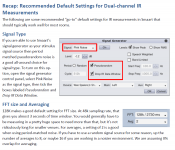
I'd use complex on all mics, as the relative phases of all are important to get right.I’ll try complex averages! Do u think I should apply that globally? Perhaps maybe leave the center mic on polar?
Complex is all about phase, whereas FDW is about how many cycles per frequency get into the display of the measurement.The complex is like a FDW isn’t that right? And I can’t find the exact terminology description for both, like what exactly do they mean by “polar😋” averaging? Is that the equivalent to measured phase in REW?
Here's another snip....i live by manuals lol

'Averaging depth' is about temporal averaging. It's a new way of describing measurement averaging period in v9. v8 gave options like 1 sec, 2 sec etc.I suppose that’s a lot of the mystery, knowing the equivalents to REW in terminology.
What about averaging depth? Do u think maybe some mics more then others and with what settings?
Don't know why the changed it.
Turn table is just a lazy susan marked for degrees on the circumference. But with it and multiple vertical mics, I can quickly grab more data than my mellon can handle.So your mic array sounds intriguing, when you said turntable, are they spinning? When h brings up a new question…

Dunno, but I'd try it further. I've rotated my syns back and forth on the turntable, and captured doing so for 10-15secs.The mic tracker, I have a eBay battery powered fan that oscillates 160 deg , I cut the fan off and mounted a mic clip to it so it can silently move a mic from left to right, I was using that before the array, do you think that single mic with the tracker on would do better? Then it’s a single mic but gets averages (not sure how that’s different from a mic array but maybe)
Then, using FirD to auto-generate a FIR file correction for that moving average, go back and measure with FIR in place for the same rotation.
Measurement comes out perfect mag and phase....which just says to me, be careful what you ask FIR to do, because it will do it ! lol
It would be so cool to figure smaart out and get the results I’m after…. The workflow is rocket fast wow it’s nice getting all that data quickly….hopefully it all works out
You'll get there and be helping me very soon, i think 🙂
That's just a function of different constant delays being in the measurements. Polarity won't change with ToF, but the apparent phase curve will.Thank you for your time
Andrew
Edit , on a side note , I was measuring and looked at my REW tune , on REW it showed flat phase from 100-20k , on smaart get this , it showed -180 from 100-4K then an incline , but the impulse still showed positive polarity… that was strange…..
Try manually bumping the transfer function delay time up and down, to see how the phase curve responds.
@mark100
Thank you , very insightful post…
Yeah that might be what I’m missing… boy I couldn’t find those pages in the manual, then I looked again and there they were I somehow skipped over that completely…
So I’m going to try these things…. Maybe this is as simple fix after all…
So what is this FirD….. I have got to try this!!
It does a inversion in phase only🙀 ?
I want it! 🥳🥳🤩🤩
Edit : if I average all my mics should I have them straight up and down? So they’re all in the center… because I have a mic bar in a row…
There’s just a couple random pictures of the set up, I’ve posted a couple of these online in various places but I should take more screenshots I suppose

Thank you , very insightful post…
Yeah that might be what I’m missing… boy I couldn’t find those pages in the manual, then I looked again and there they were I somehow skipped over that completely…
So I’m going to try these things…. Maybe this is as simple fix after all…
So what is this FirD….. I have got to try this!!
It does a inversion in phase only🙀 ?
I want it! 🥳🥳🤩🤩
Edit : if I average all my mics should I have them straight up and down? So they’re all in the center… because I have a mic bar in a row…
There’s just a couple random pictures of the set up, I’ve posted a couple of these online in various places but I should take more screenshots I suppose
Attachments
Last edited:
Yeah and see in the pic , the magnitude is all wonky because it’s a single position, which affects phase
The average is flat
The right has sub left doesn’t (don’t ask why)
These filters sound amazing , the phase is flat also …… same tune on smaart (pic in Prost above) totally strange
So yes I’m try more mics
The average is flat
The right has sub left doesn’t (don’t ask why)
These filters sound amazing , the phase is flat also …… same tune on smaart (pic in Prost above) totally strange
So yes I’m try more mics
Attachments
Here ya go...the same outfit that i linked the free averager earlier...https://eclipseaudio.com/So what is this FirD….. I have got to try this!!
It does a inversion in phase only🙀 ?
I want it! 🥳🥳🤩🤩
A bit pricy imo, but geared more for the proaudio industry. Different versions with different capabilities, and of course different prices sigh.
Like any good FIR generator, it will do whatever you ask...(given sufficient taps to work with)
Yeah I saw the link that you posted but it said averager….
Is that the correct one I want to do phase inversion…
Is that the correct one I want to do phase inversion…
Not sure what you mean by phase inversion? (or why one would want to do phase correction alone)
(i started big thread on that recently)
Any of these products will work fine. I have Fir Designer (perpetual licence) ; mainly because i need to be able to run a lot of multiple instances
https://eclipseaudio.com/comparison-table/
(i started big thread on that recently)
Any of these products will work fine. I have Fir Designer (perpetual licence) ; mainly because i need to be able to run a lot of multiple instances
https://eclipseaudio.com/comparison-table/
Like make phase flat in one click
An inverse phase response
I will have the frequency response to made flat ahead of time, so then I can take some averages and invert the phase only….
I like to use MMM with live RTA instead of sweeps, The overall sound quality is greatly improved…
And then whatever the response shape is of the averages of the sweeps, if I invert the phase , it should also match the MMM averages (because they’re intrinsically connected right)
I would not want to invert the phase without the responce being all the way flat, that would be incorrect…
I just want to use a different method for making the response flat that I feel lens to a more proper flatness as to how I hear things.
I’m not sure why sweeps don’t pan out as well , maybe you can link me to your thread and I can do some reading on what people are saying and what you were saying..
I’ve tried and tried and tried to make sweeps work for everything, and it sounds peaky at certain frequencies, and then when I do MMM , The peaks always show their ugly head, knock them down and it’s smooth again, so I would rather just do MMM from the get go then do phase after
An inverse phase response
I will have the frequency response to made flat ahead of time, so then I can take some averages and invert the phase only….
I like to use MMM with live RTA instead of sweeps, The overall sound quality is greatly improved…
And then whatever the response shape is of the averages of the sweeps, if I invert the phase , it should also match the MMM averages (because they’re intrinsically connected right)
I would not want to invert the phase without the responce being all the way flat, that would be incorrect…
I just want to use a different method for making the response flat that I feel lens to a more proper flatness as to how I hear things.
I’m not sure why sweeps don’t pan out as well , maybe you can link me to your thread and I can do some reading on what people are saying and what you were saying..
I’ve tried and tried and tried to make sweeps work for everything, and it sounds peaky at certain frequencies, and then when I do MMM , The peaks always show their ugly head, knock them down and it’s smooth again, so I would rather just do MMM from the get go then do phase after
The high frequency response of an omni mic will reduce slightly off axis, and reflections from the sound bar may affect the HF response as well.Edit : if I average all my mics should I have them straight up and down? So they’re all in the center… because I have a mic bar in a row…
Examples here:
https://www.jochenschulz.me/en/blog/which-angle-is-correct-for-the-measuring-microphone
At 8kHz the differences between 0 degrees and 90 degrees range between 1.3dB for the EMX-7150 and 2.7dB for the ECM8000. At 10kHz the deviation grows to 3.3dB, at 12kHz to 4.0dB with the ECM8000, and with the EMX-7150 1.75dB at 10kHz and 2.2dB at 12kHz.
Like make phase flat in one click
An inverse phase response
I will have the frequency response to made flat ahead of time, so then I can take some averages and invert the phase only….
Yep, FirD can do that.
It's just the more i've learned about phase correction, the less it think i think it's good idea.
If the frequency response corrections you made ahead of time (let's call them mag corrections), didn't fix phase too; then you have to find out why.
I like to use MMM with live RTA instead of sweeps, The overall sound quality is greatly improved…
Different animals, sweeps are for transfers trying to minimize room/car influence on meas. RTA is to bring room/car into meas.
Here's the thread i spoke of...not sure how much help it might be...compared to your sorting out exactly what you're after...which is always the name of the game imo.And then whatever the response shape is of the averages of the sweeps, if I invert the phase , it should also match the MMM averages (because they’re intrinsically connected right)
I would not want to invert the phase without the responce being all the way flat, that would be incorrect…
I just want to use a different method for making the response flat that I feel lens to a more proper flatness as to how I hear things.
I’m not sure why sweeps don’t pan out as well , maybe you can link me to your thread and I can do some reading on what people are saying and what you were saying..
I’ve tried and tried and tried to make sweeps work for everything, and it sounds peaky at certain frequencies, and then when I do MMM , The peaks always show their ugly head, knock them down and it’s smooth again, so I would rather just do MMM from the get go then do phase after
https://www.diyaudio.com/community/...s-a-global-phase-linearization-by-fir.393435/
Interesting….
I spent all morning watching firD videos
It looks great, and talks to smaart live…. Okay I see what the fuss is about yeah I am liking that a lot….
Okay so sweeps….. I see what you mean… so you think for driver tuning I should stay with sweeps… like , in my pics above those were sweeps of left and right
In MmM it’s dead flat, the dip at 1k and 6600 are not there in the sums…. But each respective channel in sweeps I can weird dips (that’s a 30 position average also) no matter how many averages I take those dips are there …. Pink noise . Not there and pink noise mmm sounds better so I was thinking no brainer
Okay I’ll revisit that…. Maybe I could use minimum phase eq , make the dip last flat and then do the phase correction only on the modified response. I don’t know how to get rid of the dips otherwise in sweeps and when I tune with them , like that 1k , wow it’s super obvious 1k is way too loud….
I’ll read that link!!! Thank you
I spent all morning watching firD videos
It looks great, and talks to smaart live…. Okay I see what the fuss is about yeah I am liking that a lot….
Okay so sweeps….. I see what you mean… so you think for driver tuning I should stay with sweeps… like , in my pics above those were sweeps of left and right
In MmM it’s dead flat, the dip at 1k and 6600 are not there in the sums…. But each respective channel in sweeps I can weird dips (that’s a 30 position average also) no matter how many averages I take those dips are there …. Pink noise . Not there and pink noise mmm sounds better so I was thinking no brainer
Okay I’ll revisit that…. Maybe I could use minimum phase eq , make the dip last flat and then do the phase correction only on the modified response. I don’t know how to get rid of the dips otherwise in sweeps and when I tune with them , like that 1k , wow it’s super obvious 1k is way too loud….
I’ll read that link!!! Thank you
Sorry, I have very limited experience using Smaart. So I don't have anything useful at this moment.
It won't be hard to figure out the "why" when doing measurements in a car...
Probably the worst environment one can think of to do measurements, save for a closet or bathroom.
If the frequency response corrections you made ahead of time (let's call them mag corrections), didn't fix phase too; then you have to find out why.
It won't be hard to figure out the "why" when doing measurements in a car...
Probably the worst environment one can think of to do measurements, save for a closet or bathroom.
- Home
- Loudspeakers
- Multi-Way
- Tuning a multi-way in smaart, rephase and REW. Which is best for rephase (truly)
